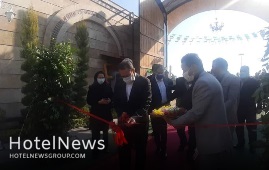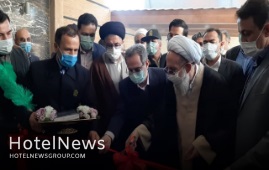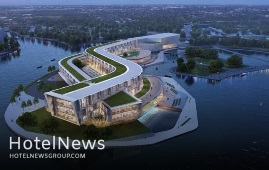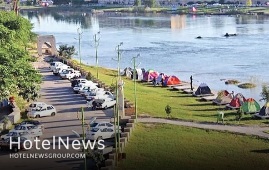
The Jerusalem Municipality, at the initiative of Mayor Moshe Leon, will begin vaccinating all hotel employees in the capital tomorrow (Tuesday). The vaccinations will be held in the coming days in a concentrated manner, for all HMO members in all the vaccination complexes throughout the city. Hotel workers, who have not yet been vaccinated, can come to the vaccine complexes to be vaccinated against the corona virus. Jerusalem Mayor Moshe Leon said that "during this period we are preparing to open tourism in the city of Jerusalem as soon as we are allowed to open by the government." "During this period, we are preparing the tourism industry for a quick and safe opening as soon as possible. All hotel employees are asked to come to the vaccination complexes. Only together can we win," Leon said.
Create: Feb 9, 2021 Edit: Feb 9, 2021 International News
The challenges the hospitality industry has faced in the wake of COVID-19 reminds us how critical the housekeeping department’s role is to a hotel’s overall success. The urgency to prevent the spread of COVID-19 has accelerated change in our industry, including the need for new hygiene and cleaning processes. Even before the virus, 78% of hotel guests believed cleanliness to be the most crucial factor affecting their choice of where to stay, with hotel cleaning protocols moving up to the #1 top-ranked category for travel with COVID-19. As guests expect the highest standards of sanitation to feel at ease in a hotel and once again return to travel, operators worldwide need to work with their housekeeping teams to better prepare for the impacts of these new realities. By using this time to further analyze housekeeping practices, hotel leaders have an opportunity to take advantage of advancing technologies to more accurately plan for operational shifts that, at the end of the day, influence bottom-line results. Here are a few ways hoteliers can prepare their housekeeping team for success in 2021. 1. Create a Structured Cleaning Program Using Industry Best PracticesTo earn guest confidence, hotels will have to demonstrate that they provide a clean and safe environment and are following specific disinfecting protocols. As part of this new dynamic, the ability to develop and implement proven strategies to meet these new cleanliness standards will be critical to staying ahead of the competition. This is a good opportunity to establish clear step-by-step standard operating procedures (SOPs) for the protocols needed to enhance cleaning regimens. Creating a distinct checklist for each area of the property, including the lobby, restrooms, common areas, fitness center, and guest rooms, will help to ensure nothing gets missed. Hotels can look to their brand or management company for guidance on a structured program, or they can leverage one from trusted industry organizations like the AHLA’s Safe Stay program or Amadeus’ disinfecting housekeeping checklist, endorsed by the International Executive Housekeeping Association (IEHA). 2. Alter Schedules for Guest Room Cleaning Based on NeedMany hotels are shifting away from daily cleaning with automatic opt-out cleaning programs, leading to, in some cases, dirtier rooms upon departure. At the same time, the enforcement of new hygiene protocols, including the expansion of high touchpoints and frequency of cleaning, can increase the amount of time needed to spend in a room. Updated practices on the use of disinfectants and surface dwell times can additionally alter the flow in which rooms are serviced. So, what does this mean for housekeeping and operational teams? The rise in guestroom cleaning times can make forecasting labor and servicing pop-up requests a more complex endeavor. Lack of planning for additional time can also cause strain on staff, while last minute modifications to departure room schedules can impact room readiness. By tracking and analyzing the labor and resources needed to execute the tasks these rooms now require, hotels can adjust to new cleaning schedules, while identifying valuable areas for improvement that will ultimately increase both staff and guest satisfaction. 3. Monitor How Many Hours Guest Rooms are VacantAs new guidance is issued for businesses to mitigate the risk of COVID-19, the procedures within hotels also need to adapt. For instance, the American Hotel & Lodging Association (AHLA) recommends rooms be left vacant for 24-72 hours prior to or after cleaning if possible, while China requires hotels that host international guests to change linens and clean guestrooms and bathrooms daily. Consumers are increasingly calculating risks associated with travel and want to have complete transparency when it comes to COVID-19-specific protocols before even booking a hotel room. The ability to promise, then track and report the number of hours a room is vacant is a must in today’s business environment. 4. Understand Which Rooms are Not Being Serviced and WhyStreamlining productivity may mean having to leave rooms not serviced for the day. Although a part of daily housekeeping, one of the biggest challenges is measuring why a room was not serviced, or “dropped”. Perhaps there is a need to alter opt-out programs. Perhaps there is a need for more staff. Having the ability to identify, record, and flag rooms with a special service status like “dropped rooms” allows teams to truly understand why rooms are not being serviced. This process allows housekeeping managers to schedule staff effectively, as well as audit and reconcile room counts at the end of each day to optimize operations. With today’s lack of time and budget, gaining important insights into dropped rooms is pivotal to every housekeeping team’s success. 5. Leverage Automation to Drive ProductivityAs we evaluate new ways to face the challenges ahead, hotel leaders must consider how innovation can play a critical role in closing the gaps between team capabilities and achieving business goals. The right hotel technology can be a powerful tool in the decision-making process by reaching across the hotel’s ecosystem to orchestrate proactive tasks such as automating room assignments, schedule turnovers, and reprioritizing work. Gaining valuable insights from automation dashboards and reporting tools can also enable better decision making in a world of unknowns. Whether it’s wiping down frequently used areas like elevator buttons, delivering guest requests like soap or chargers, or managing dropped or vacant rooms, modernizing processes with a housekeeping solution can help to maximize operational capabilities while ensuring the highest standards are met. During times of unpredictability, the ability to intelligently automate the prioritization, communication, and dispatching of the entire housekeeping operation is more valuable than ever. This way, limited time and budget is spent where it is needed most. Resetting for 2021 and BeyondMoving forward, there will be no greater focus from a guest’s perspective than a hotel’s commitment to its cleaning initiatives. Resetting for success in 2021 and beyond means understanding how technology can significantly enhance our capabilities as individuals and designing new business procedures that support it. Reflecting this dynamic presents an opportunity to lead the way in delivering the processes needed to support both housekeeping teams and guest confidence in this new era of hospitality.
Create: Feb 9, 2021 Edit: Feb 9, 2021 Housekeeping
The Marriott Dallas Uptown team is excited to announce the appointment of Robbie Tawil as General Manager of the hotel property. Tawil has more than 35 years of experience with Marriott and the hospitality industry, including previous leadership roles in management and operations. Thrilled to open the 14-story, 255 guestroom hotel, Tawil will lead Marriott into the future, opening the first Marriott property with the latest generation room design. He is well equipped to lead his team and has done so successfully in the past. During his tenure with Marriott, Tawil has served as General Manager of the Marriott Conference Center in Norman, Oklahoma, General Manager of the Worthington Renaissance, Director of Operations at the Dallas Renaissance, Director of Food and Beverage at the Worthington in Fort Worth and Director of Operations at Dallas Marriott Downtown to name a few. Despite working with properties across the country, Tawil is excited to be working again in his hometown of Dallas. “Dallas has always been my home and I am elated to be opening a hotel in my own backyard,” said Tawil. “Marriott Dallas Uptown has so much to offer the burgeoning Uptown district. We are looking forward to meeting and serving our neighbors in the surrounding communities and welcoming travelers visiting Dallas from outside our city.” Also joining the Marriott Dallas Uptown team is Juan Pablo Silva as Executive Chef of Good Graces, the hotel’s restaurant. Chef Silva’s passion for food was born while cooking with his grandmother as a child in his hometown of Lima, Peru. He furthered his knowledge at Le Cordon Bleu Peru, where he graduated with a Culinary Arts and Hotel Management degree. Chef Silva has helped manage the culinary program for the largest Ritz-Carlton in the world, The Ritz-Carlton Abu Dhabi Grand Canal, where he served as the Executive Sous Chef. After three years in Abu Dhabi, Chef Silva became the Executive Sous Chef of the Ritz-Carlton in Dallas and then Executive Chef. He is honored and excited to take on the challenge of opening Good Graces, a modern American Brasserie. “The menu I’ve created for Good Graces will truly highlight each place I’ve cooked and learned from,” said Chef Silva. “From home-cooking in my grandmother’s kitchen in Peru to fine dining at the Ritz, this menu will be the perfect balance of each.”
Create: Feb 7, 2021 Edit: Feb 7, 2021 International News
Officials of Shaner Hotels, an award winning, international hotel owner, operator and developer, today announced the grand opening of the 145-room SpringHill Suites by Marriott Columbus Dublin located in Bridge Park. Shaner will operate the hotel in a partnership with ownership, Crawford Hoying, a large-scale real estate developer headquartered in Central Ohio. The Springhill Suites by Marriott Columbus Dublin provides the freshest hotel choice in Dublin’s Bridge Park, a new development giving an urban feel to this upscale suburb,” said Plato Ghinos, president, Shaner Hotels. “The hotel provides an all-suite option that includes complimentary breakfast – providing a reliable, refreshing and unexpected choice in the Dublin market. Our staff will focus on sales, service and style to bring the best in customer service to our guests.” Situated in the heart of downtown Dublin at 4475 Bridge Park Avenue, SpringHill Suites is conveniently located near local attractions such as the Columbus Zoo & Aquarium, the highly anticipated Riverside Crossing Park and only minutes to downtown Columbus. The hotel is surrounded by numerous walkable dining and entertainment options provided by the Bridge Park neighborhood. The hotel also provides multiple amenities for travelers, including a 24/7 fitness center, 840 square feet of meeting space, a complimentary breakfast buffet, a lobby bar, multiple outdoor lounging spaces and suite-style rooms designed to fuse form and function, equipped with separate areas to both work and relax. These stylized guest rooms are furnished with an oversized work area, a phone with voicemail, free Wi-Fi, a mini-refrigerator, a microwave oven, a trundle sofa bed and Smart TV entertainment. “At the rate in which Bridge Park is growing, the demand for another hotel was obvious,” said Brent Crawford, founder and principal, Crawford Hoying. “We couldn’t be more appreciative of our continued partnership with Shaner and the fantastic hospitality provided at each of the hotels within our developments. We’re confident that Springhill Suites will be no exception.” “We continue to seek opportunities in strong primary and secondary markets with new products surrounded by multiple demand generators,” Ghinos noted. “While the pandemic has hit the travel and hospitality industries particularly hard, we believe we see the light at the end of the tunnel with the recent arrival and deployment of the vaccines. Brand new hotels such as this will hold the lead position as travelers begin their return to both business and leisure travel in the weeks and months to come.”
Create: Feb 7, 2021 Edit: Feb 7, 2021 International News
Shams ol-Emareh tourist complex was inaugurated in Baqershahr, south of Tehran province, on Wednesday on the occasion of Ten-Day Dawn (Jan. 31- Feb. 10, marking the victory anniversary of the Islamic Revolution). A budget of 370 billion rials (about $ 9 million at the official exchange rate of 42,000 rials per dollar) has been allocated to the project, Parham Janfeshan, the provincial tourism chief, addressing the opening ceremony. Constructed in an area of 11 hectares, the project is expected to create 30 job opportunities, the official added. Referring to tourism as being “advantageous” for the whole province, the official noted the tourism sector and relevant infrastructure are being developed and strengthened in all districts [and counties] of Tehran province even in low-income and deprived areas. Earlier this week, the official announced that a total of 206 tourism-related projects are scheduled to be inaugurated across the Iranian capital during the ten-day Fajr (dawn) ceremonies and celebrations. Ten accommodation centers including hotels, apartment hotels, eco-lodge units as well as tourist complexes, restaurants, and handicrafts workshops will come on stream, he explained. He also noted that a budget of seven trillion rials (about $167 million) has been allocated to the projects, which are expected to generate a total of 930 job opportunities. The mentioned projects will also add 816 beds to the hospitality sector of the Iranian capital, the official added. Hugging the lower slopes of the magnificent, snowcapped Alborz Mountains, Tehran is much more than a chaotic jumble of concrete and crazy traffic blanketed by a miasma of air pollution. This is the nation's dynamic beating heart and the place to get a handle on modern Iran and what its future will likely be. The metropolis has many to offer its visitors including Golestan Palace, Grand Bazaar, Treasury of National Jewels, National Museum of Iran, Glass & Ceramic Museum, Masoudieh Palace, Sarkis Cathedral, Tehran Museum of Contemporary Art, Carpet Museum of Iran, to name a few. The first time Tehran is mentioned in historical accounts is in an 11th-century chronicle in which it is described as a small village north of Ray. It became the capital city of the Seljuk Empire in the 11th century but later declined with factional strife between different neighborhoods and the Mongol invasion of 1220.
Create: Feb 6, 2021 Edit: Feb 6, 2021 Regional News
Iran’s southeastern Sistan-Baluchestan province has lost 1,440 billion rials ($34.2 million at the official exchange rate of 42,000 rials per dollar) in earnings from tourism as many potential visitors stay away due to the impact of the coronavirus, according to Alireza Jalalzaei, the provincial tourism chief. “Sistan-Baluchestan is a four-season travel destination and even though the province holds vast tourism capacities, it has taken some 1,440 billion rials hit from the coronavirus outbreak from mid-Esfand 1398 (early March 2020) to the end of the month Dey (January 19),” the official said on Wednesday. The official noted that Sistan-Baluchestan has set sights on [a significant] tourism development, and its travel infrastructure has been drastically extended over the past couple of years. “From the year 1396 (2017) onwards, the number of travel infrastructure in Sistan-Baluchestan has raised from 40 to 200 ones…. Nowadays tourism of this province has come to fame and distinction,” he explained. Elsewhere in his remarks, the official pointed to various tourism campaigns being launched over the past couple of years, adding the campaign ‘Let’s see Sistan, let’s hear Baluchestan’ has taken a noticeable impact on the tourism thrive of the province mainly by the means of on-line programs. “Despite all the bottlenecks, the province’s tourism has not been forced to shut….” “For instance, the occupancy rate of hotels in [the city of Chabahar] is [currently] more than 90 percent….. and currently, some 100 to 110 ecolodge unites are active across the province,” the official said. Last year, Cultural Heritage, Tourism, and Handicrafts Minister Ali-Asghar Mounesan said that the development of the travel industry across Sistan-Baluchestan province is among the top priorities for the ministry. “I am interested in Sistan-Baluchestan, and the development of this province is a priority for this ministry and the government,” the minister stated. “The majority of my travels during my tenure has been to Sistan-Baluchestan, which I consider it as a safe province with significant values in terms of culture, history, handicrafts, and tourism.” The collective province -- Sistan in the north and Baluchestan in the south -- accounts for one of the driest regions of Iran with a slight increase in rainfall from east to west, and an obvious rise in humidity in the coastal regions. In ancient times, the region was a crossword of the Indus Valley and the Babylonian civilizations. The province possesses special significance because of being located in a strategic and transit location, especially Chabahar which is the only ocean port in Iran and the best and easiest access route of the middle Asian countries to free waters. The vast province is home to several distinctive archaeological sites and natural attractions, including two UNESCO World Heritage sites, namely Shahr-e-Soukhteh (Burnt City) and Lut desert.
Create: Feb 6, 2021 Edit: Feb 6, 2021 Regional News
A hotel in South Africa is using robots to counter some of the challenges of COVID-19. Micha, Lexi and Ariel are on hand to help guests check in, find out more information about on-site facilities and deliver room service requests, as ordered via the hotel's app. Guests can even chat to the robots, whose AI-powered technology is designed to continuously improve their knowledge and interaction skills. Nikhil Ranchod, the co-founder of CTRL Robotics says: "The chatbot is pretty interesting, because these robots have quite a catchy personality. They sort of help out with the smaller things ... and where staff would usually be running up four floors delivering a meal, delivering two meals ... now we've got the facility where they can control the robots themselves and send it off." Hotel Sky in Sandton, north of Johannesburg, had put the technology in place before the pandemic, but is now embracing it as a way to minimize human contact in a country hit hard by COVID-19. The hotel's general manager, Herman Brits, says the venture also raises morale. "It just creates such a nice vibe and excitement for the staff ... They have the opportunity to be part of this journey, and being the innovators in South Africa of this hospitality trend."
Create: Feb 5, 2021 Edit: Feb 5, 2021 International News
The first-ever hotel in the city of Rey, southeast of Tehran, was inaugurated on Tuesday on the occasion of Ten-Day Dawn (Jan. 31- Feb. 10, marking the victory anniversary of the Islamic Revolution), ISNA reported. The inauguration ceremony was attended by Mohammad Mohammadi Reyshahri, the custodian of the Holy Shrine of Shah Abdol Azim, and Anushiravan Mohseni Bandpey, the governor-general of Tehran province, and several local officials and tourism insiders. A budget of 800 billion rials (about $19 million at the official exchange rate of 42,000 rials per dollar) has been allocated to the project which adds 42 rooms and 108 beds to the hospitality sector of the city, the provincial tourism chief Parham Janfeshan announced on the sidelines of the ceremony. The construction and inauguration of this hotel will lead to the development of religious tourism infrastructure in the city, which will bring more welfare to the pilgrims of the Holy Shrine of Shah Abdol Azim, Janfeshan said. Construction work of the hotel took four years in a piece of land covering more than eight hectares, he added. The history of settlement in Rey dates from the 3rd millennium BC. It is featured in the Avesta (the original document of Zoroastrianism, an Iranian religion) as a sacred place, and it is also mentioned in the book of Tobit, of the biblical Apocrypha, and by classical authors. According to Encyclopedia Britannica, Rey was one of the capital cities of the Parthian empire (3rd century BC–3rd century CE). It was captured by the Muslim Arabs in 641 CE. During the reign of the Muslim caliph al-Mahdi in the 8th century, the city grew in importance until it was rivaled in western Asia only by Damascus and Baghdad. Islamic writers described it as a city of extraordinary beauty, built largely of fired brick and brilliantly ornamented with blue faience (glazed earthenware). It continued to be an important city and was briefly a capital under the rule of the Seljuqs, but in the 12th century, it was weakened by the fierce quarrels of rival religious sects. In 1220 the city was almost entirely destroyed by the Mongols, and its inhabitants were massacred. Most of the survivors of the massacre moved to nearby Tehran, and the deserted remnants of Rey soon fell into complete ruin. Rey, however, retains enough history to give it a different sensibility, its key sight is the elaborately decorated Shah Abdol Azim Shrine. Beside the shrine complex is a lively bazaar, while further afield are a couple of minor historical attractions.
Create: Feb 5, 2021 Edit: Feb 6, 2021 Regional News
JW Marriott Hotel Shanghai Fengxian has opened, becoming the fiftieth Marriott International hotel to open in the city. Located on Hangzhou Bay in the Fengxian seaside district, just an hour’s drive south of metropolitan Shanghai, the new hotel promises to be a sophisticated and luxurious. “We are delighted to celebrate the opening of the 50th property in Shanghai, a testament to the phenomenal growth of Marriott International in this region,” said Henry Lee, president, Greater China, Marriott International. “Across Greater China, there are now over 400 Marriott hotels spanning 23 brands in more than 90 cities, indicating our confidence in the strong growth of the travel market in China. “We look forward to expanding our portfolio further, and to offer distinctive and personalized experiences to travellers here.” Fengxian is a suburban district south of Shanghai known for its rustic beachfront areas, national forest park and the old town itself, a popular weekend destination for Shanghai residents. JW Marriott Hotel Shanghai Fengxian overlooks the nearby Jianhai Lake, a wetland that connects Huangpu River and the East Sea. Designed by international design company PLD, the hotel’s style narrative is inspired by its natural surroundings, with its exterior imagined as the legendary Roc bird. Dining options at JW Marriott Hotel Shanghai Fengxian include three distinctive restaurants and a bar, with menus featuring freshly harvested produce from the hotel’s own onsite garden, JW Garden. “We are absolutely thrilled to welcome this new addition of JW Marriott in Shanghai, the fourth JW Marriott to open in this world-class city,” said Jennie Toh, vice president, brand marketing and brand management, Asia Pacific, Marriott International. “With 19 distinctive brands operating in Shanghai, we are poised to offer endless choices and curated experiences for every guest through the breadth of our portfolio.”
Create: Feb 4, 2021 Edit: Feb 4, 2021 International News
A new building is poised to transform the area around a New York City landmark and one of its busiest subway stations. Image renderings released Tuesday by RXR Realty show what would eventually be 175 Park Avenue, an 83-story tall structure that developers say will be the new Grand Hyatt hotel that will also revitalize the Grand Central Terminal with brand new public spaces. The plan is to demolish the current Grand Hyatt over the course of the next year and build the 1,646 feet tall building with up to 500 hotel rooms, 2.1 million square feet of new office space and make improvements to infrastructures around the Grand Central-42nd Street subway station. The 5,400 square feet hall would feature more signage, train schedules and arrival times, and ticketing and turnstiles will be relocated to street level to ease foot traffic. The new entrance to 42nd Street subway station will be where the ADA elevator is currently located but developers say the reconfiguration will make a more efficient route for customers with disabilities. The changes also include upgrades to the Lexington Avenue entrance where the sidewalk is expected to widen by five feet As for additional public spaces, RXR Realty said there will be three interconnected public terraces that wrap around the eastern, northern, and western sides of the building and that they will be accessible by elevator. Similar to the High Line, the Grand Central Terrace, Chrysler Terrace and Graybar Terrace will "create new vistas for pedestrians to view the neighborhood’s historic architecture" with space for outdoor seating and food and beverage concessions, the news released said.
Create: Feb 4, 2021 Edit: Feb 4, 2021 International News
Red Sea Development Company, the developer of the mammoth tourism project on Saudi Arabia’s west coast, said it awarded contracts to complete structural work for a luxury hotel and villas. Saudi Arabian contractor Al Bawani will conduct civil and structural works across 40 hotel villas on the Southern Dunes site while Swiss timber specialist Blumer Lehmann will carry out planning, construction and fabrication works for a hotel on Ummahat Al Shaykh Island, the developer said in a statement on Wednesday. The company did not disclose the value of these contracts. The contract awards "signify the start of a new phase" for the mega tourism project as it advances into hotel development, John Pagano, chief executive of the Red Sea Development Company, said. “The Red Sea Development Company has made significant progress in terms of the design and construction of key infrastructure to enable the development of hotel assets,” he added. The project is a key tenet of Saudi Arabia's tourism strategy, which aims to increase the contribution of tourism to more than 10 per cent of the kingdom’s GDP by 2030, up from 3 per cent in 2020. The Red Sea Development Company’s masterplan covers a 28,000 square kilometre site containing 90 islands. Set to welcome its first visitors in 2022, the project is expected to be completed by 2030. It will house 50 hotels containing 8,000 rooms, a luxury marina, entertainment and leisure facilities. The company, which is owned by the kingdom’s Public Investment Fund, is developing 16 hotels with 3,000 rooms across five islands and two inland sites as part of the first phase that will be delivered by 2023. This phase will cost an estimated 28 billion Saudi riyals to 29bn riyals ($7.46bn-$7.73bn) to develop. Al Bawani's work will help the developer to link villas, restaurants and central buildings within its resort, the company said. Blumer Lehmann will design and manufacture all engineered timber material for a hotel, overwater and beach villas, spa and fitness building, restaurants and an arrival building. The company said last year it had awarded contracts worth 7.5bn riyals to date. Last month, the Red Sea Development Company chose Dublin-based DAA International to operate the project's international airport. It awarded the airport design contract to UK-based architecture firm Foster + Partners in October 2019. The project is being built under a “regenerative tourism” model, which aims not only to protect local habitats, but also create conditions for local environments to thrive. Only 22 of the site's 90 islands will be built on and visitor numbers to the area will be capped at one million a year.
Create: Feb 4, 2021 Edit: Feb 4, 2021 International News
Well-planned travels during the Persian New Year (Noruz) holidays, which will start on March 20, would be possible in close coordination with the National Headquarters for Coronavirus Control, the deputy tourism minister said on Tuesday. In order to create social vitality during the holidays, the ministry has set some rules for possible Noruz trips to control and monitor them carefully, Vali Teymouri said. “The trips will be possible only within the framework of planned tours through licensed travel agencies and under the supervision of the tourism ministry.” For people, who travel individually and outside of the tours, a reservation for an authorized accommodation center will be necessary, the official added. He also emphasized that all travelers and tourists need to follow strict health protocols during their trips and stays. Last March, which is the most bustling and booming period for the tourism sector because it culminates in Noruz, all celebrations were canceled in all 31 provinces across the country, and all museums and historical sites, affiliated with the Ministry of Cultural Heritage, Tourism and Handicrafts went on a lockdown due to the coronavirus pandemic. Last year, before the Persian New year, the tourism minister Ali-Asghar Mounesan asked people to postpone or reschedule tours to help the tourism industry deal with the coronavirus outbreak. “My suggestion to my dear people is that they do not cancel their hotel reservations and domestic tours as far as possible to help the tourism industry and prevent it from bankruptcy by making their reservations in time after the virus is controlled.” Iranians made 74 million overnight stays in their domestic trips during the Noruz holidays two years ago (2019), which showed a 20 percent increase year on year. And some 132 million visits to tourist attractions were registered during the mentioned period, which showed a 34 percent growth year on year, according to data compiled by the Ministry of Cultural Heritage, Tourism and Handicrafts. The Islamic Republic was ranked the third fastest-growing tourism destination in the globe in 2019, with 27.9 percent growth year on year, according to the latest statistics released by the United Nations World Tourism Organization (UNWTO). However, the country expects to reap a bonanza from its numerous tourist spots. Under the 2025 Tourism Vision Plan, it aims to increase the number of tourist arrivals from 4.8 million in 2014 to 20 million in 2025.
Create: Feb 4, 2021 Edit: Feb 4, 2021 Regional News
